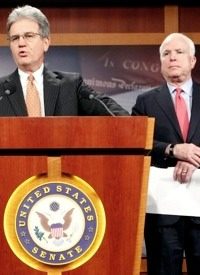
CBS News reported on December 9 that Senators John McCain (R-Ariz.) and Tom Coburn (R-Okla.) have determined that at least 15 percent of the $217 Billion dollars spent through November in the economic stimulus package has been pure waste. The list of dubious projects funded by federal stimulus funds includes some odd uses of tax dollars. These included $219,000 to study the "hookup" behavior of college coeds and $389,357 for people to keep journals of their malt liquor and marijuana use. Funding was also provided to renovate martini bars in Missouri and to conduct fossil research in Argentina.
The Obama Administration has become increasingly sensitive to the exposure of this sort of questionable use of federal funds. Not only do these and other similar projects look silly and unnecessary in a time of governmental austerity, but many of these projects appear to have little connection to job creation, which was the initial purpose of the stimulus program. One project for a footbridge over Route 1 in Foxboro, Massachusetts, for example, was listed by that state’s governor as creating 8,000 jobs. The whole cost of this project, however, was $9 Million, which makes it very hard to see how it could create very many jobs. The Foxboro project was intended to help bring in corporate research and development, none of which now appears likely to happen. Last Friday, after federal officials voiced concern about the project, Massachusetts withdrew federal stimulus funds for it.
Politicians from both political parties have for decades been pointing out the waste and nonsense of earmarked federal spending. Curbing earmarks was one of the themes of Senator McCain’s presidential bid, and it was a theme that resonated with voters. Federal earmarks, however, are tied to particular projects which can be identified and evaluated. Federal stimulus spending, on the other hand, is removed from federal congressional oversight because the funds are provided to state and local governments for whatever projects those governments wished. Typically, this process did not include any legislative oversight by the state governments (governors, not state legislatures, decided how the funds would be spent.) This effectively meant that at the federal and at the state level, the traditional power of legislatures to appropriate funds — a check upon the most egregious abuses — was completely circumvented.
The results are what anyone would suspect from the expenditure of funds with no internal checks and balances: What sounds like a good idea to a political executive is never checked or monitored. Adding to the problems, stimulus funds were intended to be spent very quickly. States were pressured to find ways to use these federal dollars for "shovel ready" projects and urged to spend these dollars as fast as possible.
Federal stimulus funds were also required to produce jobs, and the states were required to calculate the exact number of jobs created. But the methodology for this calculation was whatever seemed appropriate to the state. So, if a footbridge in Foxboro was believed likely to produce an astounding 8,000 jobs, even though the construction project itself cost a modest $9 Million, then that jobs creation number was accepted by the federal government. Indeed, there was no other way to determine how many jobs would be created (or be preserved) except the state or local government calculation. Most federal dollars to state and local governments in the past have been focused, at least in theory, on improving efficiency (reducing the need for employees.) The stimulus funds were focused on increasing jobs, even if those jobs were inefficient. It is hard to understand how creating inefficient jobs, over the long term, can have any beneficial effect on the economy. It is also hard to see how spending federal monies on projects that are patently meritless can increase confidence that these expenditures are going to help economic recovery.
Photo of Senators Coburn and McCain: AP Images



